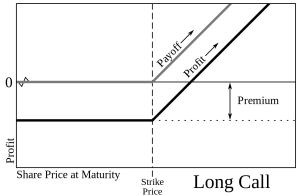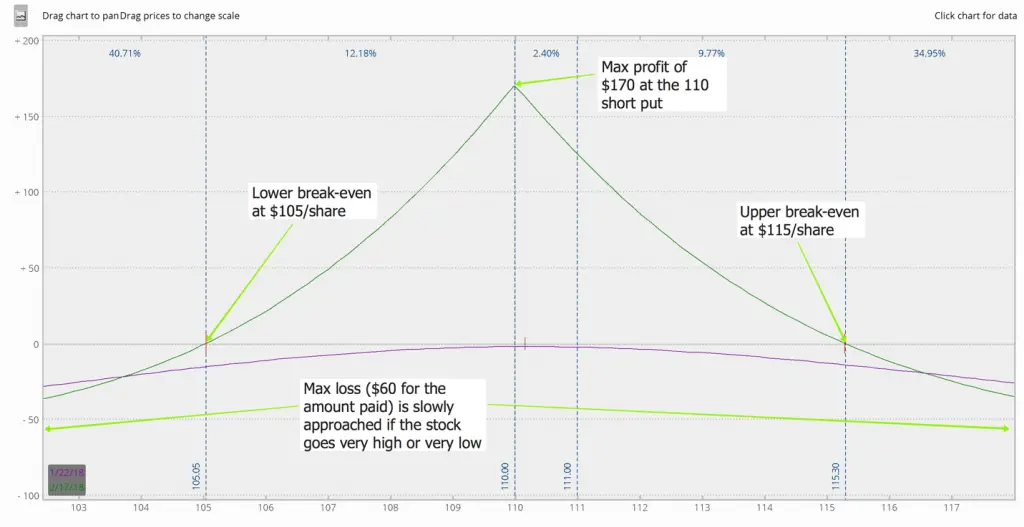Option pricing is based on the current probabilities that the option will expire in-the-money. Option contract prices are determined using the Black-Scholes pricing model for time, volatility, and the distance from the strike price. Basically the odds that the option will expire in-the-money with some intrinsic value are the main factor that goes into the mathematical model to determine the price of an option. Ultimately though it is the bid/ask prices in the open market that set what people are willing to buy and sell an option contract for. Options tend to go up as volatility increases and go down as volatility decreases. Option sellers want to be compensated for the risk they are taking on when selling options.
Option contracts are not investments in a company. Options are perishable goods. They are bets on specific prices within specific time frames.
A call option gives the buyer of the contract the right to purchase the underlying asset at a set price before expiration. The call buyer has the right to call the asset away from the option seller at the strike price of the option on the date of expiration.
A put option gives the buyer of the contract the right to sell the underlying asset to the seller of the option at the strike price on the day of expiration. The put buyer has the right to ‘put’ the asset or sell the asset to the put option seller on the date of expiration.
Options generally trade in contracts that control 100 shares of stock. For the sake of simplicity I am going to discuss stock options specifically.
On July 11th 2016 if you were to buy to open a $SPY ETF option contract at the $212 strike price with $SPY trading at $212 and the contract is quoted at $2 then the price of the contract would be $2 X 100 shares = $200 to own one option contract of $SPY at the $212 strike price. In this example it is a weekly option contract that is 5 days until expiration. The symbol for this contract could show up in your brokerage account as SPY160715C00212000 quantity 1. This ticker symbol represents a $SPY call option that expires on July 15th 2016 and has a $212 strike price. If you buy this specific call option then to be profitable on the day of expiration on July 15th then $SPY will need to close above $214 to be in-the-money and cover the cost of your option premium of $2 per share. If $SPY closes at $215 on July 15th then you will have made $100 in profit as the call option will be worth $300 in intrinsic value on expiration day and you only paid $200 in theta value for this at-the-money option. This will be explained in more detail later in the eCourse.
If you own 100 shares of $SPY and you wanted to sell a call option against your position then you could sell to open a SPY160715C00212000 (quantity 1) call option and collect the $2 option premium as a $200 credit into your account. If $SPY closes under $212 on July 15th then you would keep your option premium credit and make $200. If $SPY closed at $213 on July 15th you could buy back your short call option for $100 and you would still make $100 on the call option premium and $100 on your underlying $SPY stock appreciation. This is a simple example of a covered call. Margin is not needed if you own the underlying asset because the risk in the short call option is hedged by your long $SPY stock position.
Option contacts can expire in weekly, monthly, quarterly, and yearly time frames. There are also L.E.A.P.S. (Long-term Equity Anticipation Security) options that can expire in 2 year out time frames. There are also binary options that give the buyer an all or nothing bet on expiration.
Options are simply trading vehicles. The level of their risk is correlated to your position size and the odds of success in your time frame before the contract expiration. The same principles of profitable trading apply to options that apply to other financial markets. The difference is that with option contracts you can capture the full upside move of an underlying asset during a trend while the downside is capped to the price you paid for the option contract.
Overall the option market is not as liquid as other markets like stocks and commodity futures and volume can be an issue with the majority of option trading. The tightest bid/ask spreads for options are found where there is good volume in trading with the most popular stocks and ETFs and with options that expire weekly or in the front month or one month out. Also options with strike prices that are close to the price currently being traded are where the most liquid options are, the farther out you go from the current price in time or strike price the wider the bid/ask spreads tend to become. You can lose some open profits on option trades that are big winners when the options run deep in-the-money and become illiquid and the bid/ask spreads expand. The exit of a winning option trade can cost you a large percent of your capital at times when a winning option goes so deep in-the-money that the volume dries up and the bid/ask spread expands due to a lack of buyers interested in your deep-in-the-money contract. If you have enough capital in your option account you may decide to have an option exercised at expiration so you don’t have to lose such a high percentage of your trading capital to the expanded bid/ask spread to take the profits by selling your option.
The price of the option contract is your maximum capital exposed to the risk of loss. Options can be tools to increase the leverage of the capital that you have available and at the same time limit your risk to the downside. You can pay for the control of more shares of a stock with a small percentage of your trading capital. You have the potential for big wins and small losses built into options. You can know the full amount of capital that you can lose when you enter into an option trade, the price of the option contract is your maximum risk exposure when you buy an option. Long options present a better risk reward ratio than short options because long options allow you to risk a small amount of money to make a large amount. While selling options short with no hedge leave you risking a lot of money for the chance to make a little. Short option positions that have a hedge in place to limit losses can create a good winning percentage system. There are many ways to trade with options that we will be exploring in this eCourse.
The same universal principles of profitable trading apply to option trading. Option trading requires proper position sizing and the right mindset. You also must trade options with an edge over others to be profitable. You must have a high winning percentage with small losses on your losing trades or your winning trades must be so much bigger than your losing trades if you have a lower win rate.
Options give you more possibilities for profitability as a trader than just betting on a direction. It is possible with options to have winning strategies where it does not matter which direction the market goes in. You can make a trade that bets the market goes nowhere. You can trade volatility or bet on a specific move within a set time frame. You can act like a casino and sell options that give the buyer of the options a very low probability of profit. Options offer a huge variety of ways to structure trades and bets on volatility, trends, ranges, and a lack of a trend that stocks and commodities alone do not offer.
One example is the Iron Condor option trade – the option trader sells out-of-the-money options and buys options that are further out-of-the-money. The option trader makes money if the trend doesn’t reach the long options contracts and they expire worthless, he can win with any direction of the trend; the trade is attempting to judge the potential probabilities of the lack of the trend’s magnitude. With this type of option trade it is critical for the option trader to carefully monitor the risk of the position the few times that the underlying asset actually trends all the way to the strike of the long options. With options you can buy a hedge or buy to close the short option instead of using stop losses.
Just like with stocks and commodities there are option systems with high and low win rates. Just like with trading other markets profitability lies in not having big losses whether you are long or short options. An option trader must manage the losses and keep them small so they don’t give back the profits from all the winning trades. The option market is very efficient and accurate overall in their pricing model. In the long term over a large sample of trades and multiple market environments all options strategies tend to end up eventually breaking even. The edge in option trading comes primarily from cutting those losses when you are having a short trade go against you or maximizing your winning trades when you are long options and it is going in your favor. Hedging short options or unwinding the position when it goes too far against you is crucial for profitable option trading on the short side. Each option system has an inverse system, just like there are long and short stock strategies. You can be long an option strangle or short an option strangle. Be aware there is always someone on the other side of your trade. Every option contract has someone short and someone long at all times. Option contracts are always two sided bets with a winner and a loser unlike the stock market. Contract markets are zero sum games for buyers and sellers. If you own a stock someone is not necessarily short the stock you own. Options are fungible assets so that the trades executed on them are interchangeable. If you sell to open an option you will not be buying it back from exactly the same person you sold it to, they are traded on an open market.
There is no magical Holy Grail option trading strategy where you just print money with no losses. Different market environments can cause particular option strategies to fail to profitable. The profitability comes from the math of your big wins and small losses or high winning percentage if losses are kept small. Risk management, position sizing, consistency of execution, and a robust systematic process are the real Holy Grails of option trading.
For an option trader to create a profitable option system they must understand how they are priced and how they move in price. After you understand available option strategies it will be up to you to individually design an option trading system that fits your risk tolerance and desired screen time. Rolling out your own option trading system and process could take you first to paper trading and then to a demo account just to understand how the prices can move with the market in real time. When you have done some paper trading and practice watching option prices move you should then be more comfortable trading options with real money in real time.
Option trading presents some great opportunities to make money with the right process.
This is the introduction from my Options 101 eCourse that I created to give a short cut to stock traders that want a quick and easy way to learn how stock options work.

